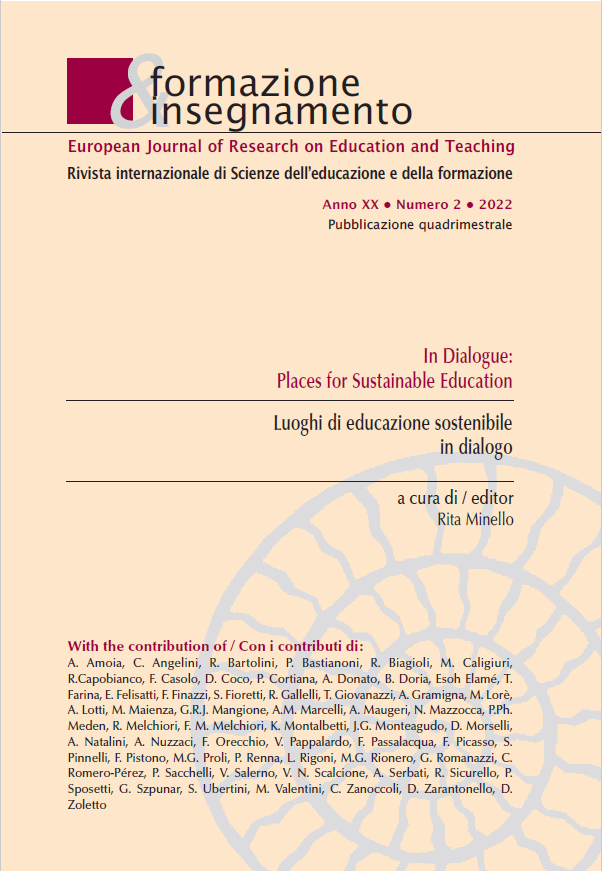The development of personality through physical movement during infancy
DOI:
https://doi.org/10.7346/-fei-XX-02-22_29Keywords:
Personality, Physical education, Infancy, Development, MovementAbstract
This article reports a systematic review carried out with the aim of scientifically validating the influence that motor activity and movement in general could have on the personality confirming an individual’s uniqueness and unity, influenced by the experiences he/she lives and the environment around him/she. Is introduced the concept of personality, particularly related to motor aspect in the growing age and are taken into consideration the areas in which it is divided: motor, cognitive, relational and emotional; then 12 articles are analysed concerning motility in the form of game-sport, physical education or just movement and the effects that it produces on the overall development of individuals in preschool and school age, from 0 to 10/11 years old.
References
Ali, A., Pigou, D., Clarke, L., & McLachlan, C. (2017). Literature Review on Motor Skill and Physical Activity in Preschool Children in New Zealand. Advances in Physical Education, 7, 10-26.
Bailey, R. (2006). Physical Education and Sport in Schools: A Review of Benefits and Outcomes. Journal of School Health, 76, 8.
Bart, O., Hajami, D., & Bar-Haim, Y. (2007). Predicting School Adjustment from Motor Abilities in Kindergarten. Infant and Child Development, 16, 597-615.
Biddle, S. J. H., & Asare, M. (2011). Physical activity and mental health in children and adolescents: a review of reviews. British Journal of Sports Medicine, 45, 886-895.
Bidzan-Bluma, I., & Lipowska, M. (2018). Physical Activity and Cognitive Functioning of Children: A Systematic Review. International Journal of Environmental Research and Public Health, 15, 800.
Canevaro, A. (1976). I bambini che si perdono nel bosco. Identità e linguaggi nell’infanzia. Firenze: La Nuova Italia.
Cepero González, M., Marín Regalado, M.N., & Torres Guerrero, J. (2010). Teaching and learning social values: experience of resolution of conflicts in the classroom of physical education across the learning of social skills. Journal of human sport & exercise, 5, 3.
Commissione europea (n.d.). Educazione fisica e sport a scuola in Europa. Eurydice.
Conferenza Generale dell’Organizzazione delle Nazioni Unite (ONU) per l’Educazione, la Scienza e la Cultura (1978). Carta internazionale per l’educazione fisica e lo sport. Pace, diritti dell’uomo, diritti dei popoli, anno II, numero 1, 1988.
De Ajuriaguerra, J. (1993). Manuale di psichiatria del bambino (Gentili, P. & Marciani, A. Trad.). Milano: Masson. (Originariamente pubblicato nel 1974).
Deforche, B., De Bourdeaudhuij, I., D’hondt, E., & Cardon, G. (2009). Objectively measured physical activity, physical activity related personality and body mass index in 6- to 10-yr-old children: a cross-sectional study. International Journal of Behavioral Nutrition and Physical Activity, 6, 25.
De Pascalis, P. (2010). Il giovane campione. Lo sviluppo psicomotorio in età evolutiva: il ruolo della motricità. Roma: Aracne.
Ferrière, A. (1953). L’autonomia degli scolari. Firenze: La Nuova Italia.
Freinet, C. (1976). Le mie tecniche (Valeria, S. Trad.). Firenze: La Nuova Italia. (Originariamente pubblicato nel 1967).
Gross, J. J. (2007). Handbook of emotion regulation. New York: Guilford Press.
Guerra, M. (2019). Le più piccole cose. L’esplorazione come esperienza educativa. Milano: Franco Angeli.
Hampson, S. E., Goldberg, L.R., Vogt, T.M., & Dubanoski, J.P. (2006). Forty Years On: Teachers’ Assessments of Children’s Personality Traits Predict Self-Reported Health Behaviors and Outcomes at Midlife. Health Psychology, 25(1), 57-64.
Magnani, F. (2016). Sport e formazione del carattere. Notizie dal Sacro Monte di Varese.
Ministero dell’Istruzione, dell’Università e della Ricerca (MIUR) (2012). Indicazioni nazionali per il curricolo della scuola dell’infanzia e del primo ciclo d’istruzione. Annali della Pubblica Istruzione, numero speciale. Firenze: Le Monnier.
Piaget, J. (2000). Lo sviluppo mentale del bambino e altri studi di psicologia (Zamorani, E. Trad.). Torino: Einaudi. (Originariamente pubblicato nel 1964).
Teixeira, P. J., Carraça, E. V., Markland, D., Silva, M. N., & Ryan, R. M. (2012). Exercise, physical activity, and self-determination theory: A systematic review. International Journal of Behavioral Nutrition and Physical Activity, 9, 78.
Timmons, B. W., Naylor, P.J., & Pfeiffer, K.A. (2007). Physical activity for preschool children – how much and how? Applied Physiology, Nutrition, and Metabolism, 32, S122-S134.
Trost, S. G. (2007). Active education: Physical Education, Physical Activity and Academic Performance. Robert Wood Johnson Foundation.
Valentini, M., Cinti, F., & Troiano, G. (2018). Crescita e apprendimento attraverso il corpo in movimento. Formazione & Insegnamento, XVI, 1.
Valentini, M., Mezzelani, E., Marziani, G., Di Tore, S., & Federici, A. (2012). School: a coloured world of a everyday reality performance analysis: motor project of educational research for an effective integration. Journal of human sport & exercise, 7, 1.
Valentini, M., Palmieri, M., & Lucertini, F. (2016). Attività motoria come “farmaco” per lo sviluppo della personalità in età evolutiva: revisione della letteratura. Revista Latinoamericana de Educatión Infantil, 5 (2), 137-157.
Vygotskij, L. S. (1990). Pensiero e linguaggio (Mecacci, L., Trad.). Roma-Bari: Laterza. (Originariamente pubblicato nel 1934).
Downloads
Published
How to Cite
Issue
Section
License
Copyright (c) 2022 Manuela Valentini, Silvia Ubertini

This work is licensed under a Creative Commons Attribution 4.0 International License.
Formazione & insegnamento is distributed under Attribution 4.0 International (CC BY 4.0).
For further details, please refer to our Repository & Archiving Policy, as well as our Copyright & Licensing Terms.





